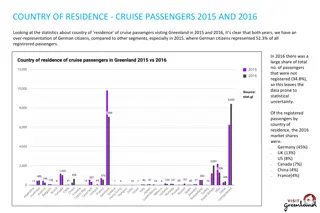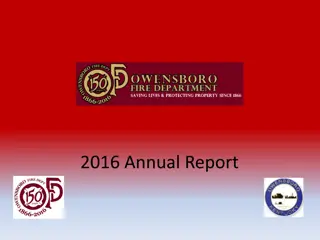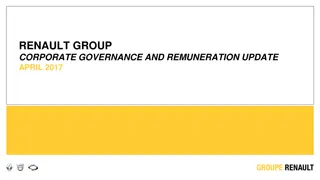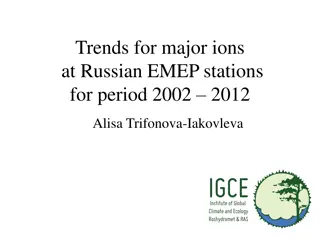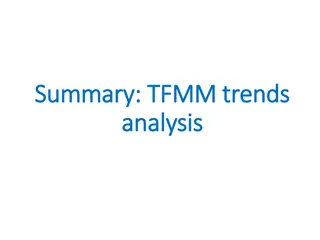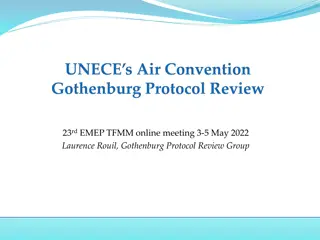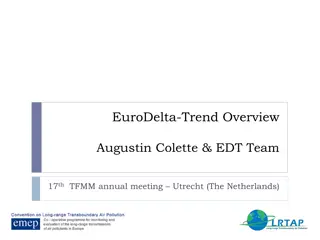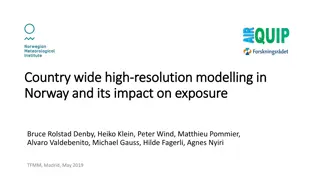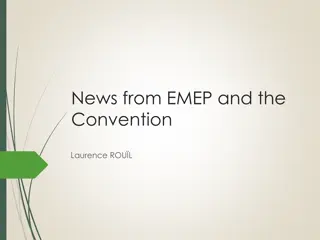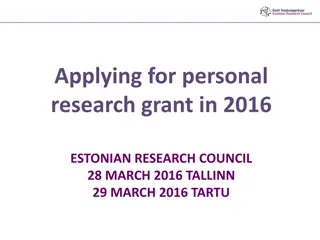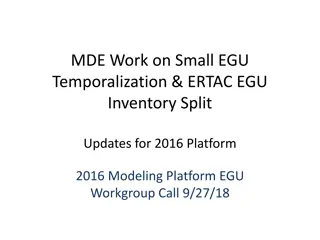
Evaluation and Comparison of Chemical Mechanisms for Air Quality Policy Assessment
Explore the intercomparison and evaluation of various chemical mechanisms for assessing air quality policies, focusing on reducing mechanisms, model experiments, and evaluation protocols. This presentation covers the study of reduced chemical mechanisms against a gold standard, mechanism reduction techniques, evaluation protocols, and model experiments using STOCHEM-CRI. Learn about the methods used for mechanism reduction, protocol for evaluation, and model experiments conducted for air quality policy assessment.
Download Presentation

Please find below an Image/Link to download the presentation.
The content on the website is provided AS IS for your information and personal use only. It may not be sold, licensed, or shared on other websites without obtaining consent from the author. If you encounter any issues during the download, it is possible that the publisher has removed the file from their server.
You are allowed to download the files provided on this website for personal or commercial use, subject to the condition that they are used lawfully. All files are the property of their respective owners.
The content on the website is provided AS IS for your information and personal use only. It may not be sold, licensed, or shared on other websites without obtaining consent from the author.
E N D
Presentation Transcript
INTERCOMPARISON AND EVALUATION OF CHEMICAL MECHANISMS FOR AIR QUALITY POLICY ASSESSMENT Dick Derwent rdscientific, Newbury, UK 17thMeeting of the EMEP Task Force on Measurement and Modelling Utrecht, Netherlands 19thMay 2016
SUMMARY OF PRESENTATION 1. Reduced chemical mechanisms 2. The constrained Zero-D model 3. Comparison of ozone responses to NOxand VOC controls 4. Comparison of OH responses to NOxand VOC controls
SUMMARY OF REDUCED CHEMICAL MECHANISMS STUDIED CB05 CB6 SAPRC-99 CS07A GEOS-CHEM CRIv2 These are evaluated against the gold standard mechanism which we will take as the Master Chemical Mechanism v3.3.
MECHANISM REDUCTION TECHNIQUES Lumping reaction products Reaction products are no longer identifiable compounds but represent a series of compounds such as aldehydes or ketones Lumping VOCs Emitted VOCs are no longer identifiable compounds but are represented by surrogate species that are mixtures of emitted VOCs These techniques complicate mechanism evaluation. These techniques are not employed in the MCMv3.3 or CRIv2 which are entirely explicit mechanisms.
MECHANISM EVALUATION PROTOCOL Harmonise as much evaluation data as possible Standardise the inorganic chemistry to IUPAC Standardise the photolysis rate data Standardise the PAN chemistry to the MCMv3.3 Restrict VOC coverage to simple VOC species and not to surrogate emission species Supply standard background environmental conditions
STOCHEM-CRI MODEL EXPERIMENTS STOCHEM-CRI is a global Lagrangian 3-D chemistry transport model spin-up: 1stOctober to 31stMarch model experiment: 1stApril to 31stDecember European study region: 40 olatitude x 40 olongitude results for 1 month * 32 grid boxes runs with CRIv2 250 chemical species 650 chemical reactions Employed here to provide background environmental conditions.
LOCATIONS OF THE CHOSEN CHEMICAL ENVIRONMENTS 25 LATITUDE RANGE FROM 35oN TO 55oN 26 LOCATIONS WERE CHOSEN FROM THE OUTPUT OF THE STOCHEM MODEL AT 5o x 5o INTERVALS 27 28 29 30 32 31 17 18 19 LONGITUDE RANGE FROM 10oW TO 30oE 20 21 24 22 23 9 10 11 12 13 16 14 15 1 2 3 4 5 8 6 7
ZERO-DIMENSIONAL (0-D) BOX MODEL STUDIES chemistry mechanisms studied include Master Chemical Mechanism v3.3, CRIv2, SAPRC-99 and -07, CB05 and CB-6, GEOS-CHEM all mechanisms have been standardised run in box model with no dry deposition or exchange with free troposphere composition taken from STOCHEM-CRI run for 30 long lifetime (>1 hour) chemical species composition constrained to STOCHEM values by addition or subtraction of fluxes for each long lifetime species at end of every time step model run for 5 days outputs are time-averaged constrained fluxes or time profiles of short lifetime species
MIXING RATIO CONSTRAINED ZERO-D MODEL d[O3]/dt = P - l[O3] Net photochemical production Constraint level [O3] Net photochemical destruction d[O3]/dt = 0 = P - l[O3] + flux This accomplished at every time step within the GEAR s method numerical integrator
SPECIES WITH CONSTRAINED MIXING RATIOS ozone, NO, NO2, HNO3, PAN, MPAN CH4, H2, CO H2O2, CH3OOH C2H6, C3H8, nC4H10 C2H4, C3H6, trans-but-2-ene C2H2,benzene, toluene, o-xylene isoprene, -pinene, -pinene HCHO, CH3CHO, CH3COCH3, CH3COC2H5, CH3OH, C2H5CHO The Gear s method integrator returns the rates of production or destruction required to maintain the constrained mixing ratio of each species. Not all of these species are in all the mechanisms studied. Species without constraints are allowed to run free eg. OH, HO2 etc
STANDARDISING THE CHEMICAL MECHANISMS MCMv3.3 and CRIv2 were left as downloaded. The condensed mechanisms were standardised as follows: inorganic chemistry was replaced with a common set of IUPAC reactions and rate coefficients all photolysis rate coefficients were replaced with a common set from the MCM website all PAN-type rate coefficients were replaced with the MCMv3.3 values To indicate that the mechanisms are not used as described by mechanism developers we signify this by use of italics.
12 Photochemical ozone production rate, ppb per hour 10 All the mechanisms exactly overlap Dispersion between the model results is within 4% 8 6 Standardisation and harmonisation steps have not introduced significant bias into the model results 4 2 0 1 2 3 4 5 6 7 8 9 10 11 12 13 14 15 16 17 18 19 20 21 22 23 24 25 26 27 28 29 30 31 32 Model experiment number CB05 CB6 CRI2 GEOS CHEM MCMv3.3 SAPRC07 SAPRC99
Dispersion is large below 1.5 ppb Dispersion is narrow above 1.5 ppb 1 Some cb6 points produce more ozone compared with MCMv3.3 0.5 Differences in % from MCMv3.3 in O3 production rate 0 0 0.5 1 1.5 2 2.5 3 3.5 NOx, ppb -0.5 Most mechanisms produce slightly less ozone compared with MCMv3.3 -1 -1.5 -2 Ozone production rates agree between the mechanisms to within 4% -2.5 -3 All GEOS-CHEM and cb05 produce much less ozone compared with MCMv3.3 -3.5 -4 CB05 CB6 CRI2 GEOS CHEM SAPRC07 SAPRC99
1.4E+07 MCMv3.3 predicts significantly lower OH number densities compared with the other mechanisms 1.2E+07 OH radical number density, molecule cm-3 1.0E+07 Standardisation and harmonisation have not introduced significant bias between the mechanisms 8.0E+06 6.0E+06 4.0E+06 2.0E+06 0.0E+00 Detailed analysis of one chosen environment out of the 32 68400 79200 90000 100800 111600 122400 133200 144000 154800 165600 176400 187200 198000 208800 219600 230400 241200 252000 262800 273600 284400 295200 306000 316800 327600 338400 349200 360000 370800 381600 392400 403200 414000 424800 435600 446400 457200 468000 478800 489600 cb05 cb6 CRI2 GEOS-CHEM MCMv3.3 SAPRC07 SAPRC99
VOC limited NOx limited 8.0E-07 Circle points above squares Response in normalised ozone production rate, ppb per hour per 7.0E-07 -30% NOx responses > -30% VOC responses 6.0E-07 5.0E-07 molecule per cm-3 4.0E-07 3.0E-07 2.0E-07 1.0E-07 0.0E+00 0 10 20 30 40 50 60 70 80 -1.0E-07 [O3]/[NOz] CB05 -30% NOx CB6 -30% NOx CRI2 -30% NOx GEOS CHEM -30% NOx MCMv3.3 -30% NOx SAPRC07 -30% NOx SAPRC99 -30% NOx CB05 -30%VOC CB6 -30%VOC CRI2 -30%VOC GEOS CHEM -30%VOC MCMv3.3 -30%VOC SAPRC07 -30%VOC SAPRC99 -30%VOC
2.50E-07 Response in normalised ozone production rate to -30% VOC 2.00E-07 FOR A GIVEN NOx RESPONSE THERE IS AN UPPER LIMIT TO THE VOC RESPONSE VOC response 1.50E-07 THE UPPER LIMIT TO THE VOC RESPONSE IS LESS THAN ONE HALF OF THE NOx RESPONSE 1.00E-07 5.00E-08 THESE ENVIRONMENTS ARE NOx LIMITED NOx response 0.00E+00 0.00E+00 5.00E-08 1.00E-07 1.50E-07 2.00E-07 2.50E-07 3.00E-07 3.50E-07 4.00E-07 Response in normalised ozone production rate to -30% NOx CB05 CB6 CRI2 GEOS CHEM MCMv3.3 SAPRC07 SAPRC99
OZONE RESPONSES TO POLICY OPTIONS ARE MECHANISM DEPENDENT Mechanism Relative response to -30% NOx reduction Relative response to -30% VOC reduction cb05 0.732 0.975 cb6 0.841 1.100 CRIv2 0.901 1.230 GEOS-CHEM 0.733 0.744 MCMv3.3 1.0 1.0 SAPRC-07 1.100 1.100 SAPRC-99 1.330 1.330 These ozone responses have been averaged over all 32 environments
6.0E+06 5.0E+06 OH radical number density, molecule cm-3 4.0E+06 3.0E+06 2.0E+06 1.0E+06 0.0E+00 0 0.5 1 1.5 2 2.5 3 3.5 NOx, ppb CB05 CB6 CRI2 GEOS CHEM MCMv3.3 SAPRC07 SAPRC99
6.0E+05 OH increases 4.0E+05 Responses in OH number density to -30% NOx 2.0E+05 reduction, molecule cm-3 0.0E+00 0 0.5 1 1.5 2 2.5 3 3.5 OH decreases -2.0E+05 -4.0E+05 -6.0E+05 -8.0E+05 NOx, ppb CB05 CB6 CRI2 GEOS CHEM MCMv3.3 SAPRC07 SAPRC99
6.0E+05 Response in OH number density to -30% VOC reduction, 5.0E+05 4.0E+05 OH increases molecule cm-3 3.0E+05 2.0E+05 1.0E+05 0.0E+00 0 0.5 1 1.5 2 2.5 3 3.5 NOx, ppb CB05 CB6 CRI2 GEOS CHEM MCMv3.3 SAPRC07 SAPRC99
RESPONSESINOH RADICAL NUMBER DENSITIES TO POLICY OPTIONS ARE MECHANISM DEPENDENT Mechanism Relative response to -30% NOx reduction Relative response to -30% VOC reduction cb05 1.50 1.43 cb6 1.21 1.14 CRIv2 1.40 1.41 GEOS-CHEM 1.43 1.16 MCMv3.3 1.0 1.0 SAPRC-07 1.36 1.49 SAPRC-99 1.39 1.60 These responses in OH radical number densities have been averaged over all 32 environments
CONCLUSIONS Six reduced chemical mechanisms have been compared against the MCMv3.3 under European background environmental conditions with the following conclusions: Photochemical ozone production rates agree to within 4% Responses in ozone to -30% NOx reductions are much greater than those to -30% VOC reductions Nevertheless, responses in ozone to -30% NOx and VOC reductions show significant variations between mechanisms Most mechanisms predict much higher OH radical number densities compared with the MCMv3.3 Responses in average OH radical number densities show significant variations between mechanisms

